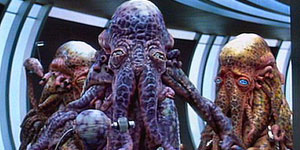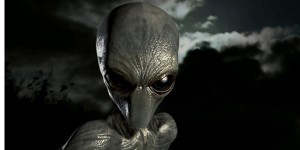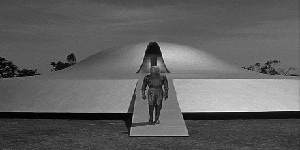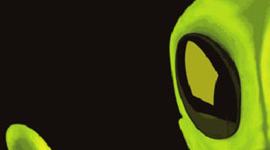Welcome to Ask 5 Friends. With the diversity of people in the Science Fiction arena, a writer has only to reach out to a fellow Science Fiction author for help. We hunt down friends whose “day job” is relevant or who have the writing experience to talk us through a tough spot. So, I’m going to pose a question to five experienced authors and author/scientists for their opinion.
Today’s Question: Heavy World-Heavy Aliens?
In the world of Science Fiction, aliens come from the minds of their creators, but as we look further into the stars, we can’t help but ask if we’re getting it right. Every day we’re finding more planets in the Goldilocks zones and scientists debate the environments of those worlds. Along with environments, they can’t help but wonder how life forms on those new worlds would appear. Unfortunately, without FTL space travel, we won’t in our lifetimes find out how right or wrong we are.
That certainly doesn’t stop us from creating alien characters for our audiences. So let’s “Ask 5 Friends” what they’d expect to find.
Since we’re hearing so much about the Kepler telescope’s discoveries, let’s start with a man who’s got his hands in that field, but his imagination in Science Fiction: Author and Astronomer David Lee Summers:
Based on recent discoveries, Kepler-62f is one of the most Earth-like exoplanets now known. It’s only 40% larger than the Earth and smack in the middle of its star’s habitable zone. So, what kind of life will live on this world? A classic science fiction writer from the 50s or 60s might have imagined a humanoid alien, built stocky and strong because they evolved in the high gravity of the world.
That’s not necessarily a bad starting place, but who says the alien needs to be humanoid? What if intelligent creatures evolved in the oceans? A buoyant creature could be smaller than a human. They could also be a lot bigger. What if the creature can fly? In which case, being smaller and lighter might actually be an advantage, even on a planet that’s more massive than the Earth.
When one tries to imagine life on an alien planet, I think the first thing to do is look at the wonderful biodiversity on this planet. There are small creatures and large ones. All you need to be intelligent is have a way to carry a sufficiently large brain, and probably a way to build tools so that the intelligence can be recognized. Sure, the intelligent creature from Kepler-62f will probably find they can propel themselves with startling ease on Earth, while we’d feel like we were being crushed by our own body weight on their planet, but there are still many possibilities for exactly what that life would look like.
David Lee Summers is co-editor with Steve B. Howel, Project Scientist of the Kepler mission. A Kepler’s Dozen is an anthology presenting stories set on or near thirteen planets discovered by NASA’s Kepler mission. Learn more about A Kepler’s Dozen at http://www.hadrosaur.com/kepler.html. A Kepler’s Dozen is also available from Amazon. David Lee Summers writes in multiple genres. Go to http://www.davidleesummers.com to find out more about the Clockwork Legion series, the Old Star/New Earth series, and Scarlet Order Vampires series.
As we would have difficulty moving about on alien worlds of different gravities, the same goes for aliens visiting ours, depending upon their home world. That may be one of the many reasons we haven’t openly been visited by aliens. That’s not even taking into account immunology. One little alien bug could wipe out every species on the planet. Theirs or ours.
These factors could mean there’d be little reason for aliens to visit our world. If that happened, some scientists speculate it would be for less than neighborly intentions, at which point we might not want to find anyone knocking on our cosmic door.
However, our next friend brings her aliens to Earth with an Armani flair that has at least half the population gladly opening the door and lustfully letting our neighbors in our beds… I mean abodes. Let’s ask Gini Koch, author of the Alien Series:
What would I find on my Goldilocks planet?
Because I write science fiction, where I have aliens from other planets active on Earth, I’ve actually given this some thought.
I have my main aliens coming from a desert planet with two suns, since I chose Alpha Centauri as their home solar system. They’re humanoid, and in order to survive, they have two hearts. They’re also stronger and faster than humans, with higher stamina and faster regeneration, (which is a particularly pleasant feature in the bedroom and ensures that once
you go alien, you never go back), in part because of the two hearts.I went with the assumption that this Goldilocks planet, and the others in its system, created the need for multiple hearts for most of the races, and higher strength and speed as well, based on their locations to and orbits around their twin suns.
On their home planets, these beings aren’t as wondrous as they appear on Earth. They’re just regular back home, appropriate for the heavier pull of gravity. But Earth’s weaker gravitational pull allows them, when they’re here, to be superheroes.
Find out more about Gini Koch at http://www.ginikoch.com Buy Alien in the House, Alien vs. Alien, Alien Diplomacy, Alien Proliferation, Alien in the Family, Alien Tango, and Touched by an Alien right NOW online or at a bookstore near you! Alien Research releases December 3, 2013. Pre-order your copy from your local bookstore or online today!
Be still my beating heart. After reading all Gini’s available Alien novels, I’m waiting for my superhero AC. Guys, don’t despair. The AC Dazzlers are looking for men with brains and not in the Zombie sense. These Dazzlers also have the same ‘superpowers’ and two hearts beating just for you.
Leaping into the concept of multiple organs to deal with different environments, it is a viable theory. Why do we possess two kidneys and two lungs, among other duplications? How many naturally one-eyed creatures have you ever seen? Get your minds out of the gutter! There’s a reason for multiple organs. We can lose or donate one and survive. In a few cases, humans have even lost a hemisphere of their brain and still function. And yes, I’m sure your multiple eyes darted around the room to a likely suspect.
These duplications and strange configurations have evolved from the second we crawled out of our primordial ooze, with oh so much variety. Dinosaurs, such as the saurichians, had high metabolisms supported by a respiratory system that included not just their lungs, but airsacs to extend the function of those lungs. There were also cavities that ran through many of the bones, making them hollow and allowing more oxygen to be passed through these large beasts. As the oxygen content rose, these creatures grew bigger and bigger, as much as 190 ft. long, based on the discovery of partial vertebrates of an Amphicoelias fragillimus.
To speak about the anatomy of aliens, let’s go to Dr. Bruce Davis, Trauma Surgeon and Science Fiction Author:
Speaking to the anatomy of aliens. I liked Hal Clement’s, Mesklinites.
They were from a heavy world with a metabolism based on liquid methane. They were small, caterpillar like creatures with the ability to lift their heads and front body segments upright so they could use tools. Clement got it right for the time in which he wrote (1970 I think).The limiting factor for alien life forms is their metabolism. If you are carbon-oxygen, size is determined not by gravity, but by the oxygen tension of the atmosphere and your ability to distribute it to your cells. Look at the size difference between dinosaurs and modern terrestrial animals. One reason they could be so much bigger is that the rising oxygen content of the Jurassic and Triassic periods was a couple of percent higher than today.
Dr. Bruce C. Davis, besides being a trauma surgeon is a Science Fiction author of The Profit series. Also – That Which is Human and Blanktown. You can read more about Dr. Davis on his website is http://www.thatwhichishuman.com or you purchase his books through http://www.AKWbooks.com
The era of dinosaurs didn’t just bring us 190 foot beasts. Some dinosaurs were small, less than 20 inches. Unfortunately their fragile bones rarely survived long enough for fossilization. There were also tiny mammals the size of field mice, who could burrow underground. They survived and evolved when the dinosaurs died off. Out of the bones of the past rose one species after another, until humans became the dominant threat on our planet.
Since we’re speaking of building off bones of dinosaurs, we move to Marsheila Rockwell, Civil Engineer and Fantasy Author
Though I’m better known for building with words, I’m also a registered civil engineer and have spent a lot of time designing things to be built with less nebulous materials, like wood, steel, and concrete.
One of the main principles in engineering is that whatever you design has to be able to withstand the forces acting on it. This principle applies to biological constructs (like humans, or aliens) just as much as it does to physical ones (like, say, giant white statues of Jesus). Which means that a biological life form that evolves on any particular planet has to be able to withstand the forces generated by that planet, like its gravity.
We would therefore expect that a life form that evolved on a high-gravity (“heavy”) planet would be stronger than one that evolved on a low-gravity planet. Does that mean a race of Dwayne Johnsons? Not necessarily – it would likely depend on the building blocks of life that were available to that planet, an area which is sadly outside my expertise.
One thing I can tell you for sure, though – if there’s a planet out there populated by clones of The Rock, I’ll be on the first outbound spaceship!
Marsheila (Marcy) Rockwell’s work includes three novels for Wizards of the Coast (Skein of Shadows, 2012; The Shard Axe, 2011; and Legacy of Wolves, 2007), the Tales of Sand and Sorcery collection from Musa Publishing, Bridges of Longing and Other Strange Passageways. Find out more here: http://www.marsheilarockwell.com
So far we’ve looked at real worlds discovered through the Kepler telescope, taking into account real science with a twist of humor. We’ve looked at our own world for examples of what to expect, from the dinosaurs of our past to the vast creatures in our modern world. Writers have this wealth of information to draw from.
We’ve grasped fears we have of our own species and translated them into our aliens. We can look at the movies and we’re not talking Superman. Everyone knows Aliens and/or Predators. What the hell was their evolutionary path? How about Independence Day, or Men in Black? Funny, yes, but ewwww. Oh, and we can’t forget the Bugs from Starship Troopers!
Addressing the danger of aliens some far off human colonist might face, we go to our final friend, Science Fiction author Saul Garnell.
In my opinion, the shape of alien life forms depending on gravity is a secondary issue. First, I would check for long sharp teeth, claws, poisonous quills and any other damn thing that would lead to an untimely death. Sure, smarty-pants scientists estimate that low gravity will allow the evolution of tall, elongated anatomies. But who cares? Whether I found such creatures interesting would depend solely on their ability to eat me. The same goes for short squatty things expected on higher gravity worlds.
Actually, I take that back. Anatomy would be the third thing on my list. Turning said alien creature into a nice gumbo takes second place. Oh, you find that shocking? Before anyone gets all uppity about eating non-sentient alien life, I’d ask these same people to explain their behavior on this planet. Excluding vegans (who will disappear when we start printing edible meat), why should we expect humankind to act differently while moving about the cosmos? It’s as though morality changes when traveling. Come to think of it, people’s morality does change when far from home: by my estimation it gets far worse.
So in summation, whether it’s high or low gravity, always ensure you’re not the prey. Because even if you find an alien creature’s anatomy fascinating, it won’t do you much good if you’re inside it being digested.
Saul Garnell recently released The Freedom Club, available at Amazon.com Also available is the Star Hound series with co-author David Bischoff. To find out more about Saul Garnell (or his other pen name S. Ron Mars) go to: http://voodoorobotchili.wordpress.com
In summation, we don’t know what we’ll find out there, or coming our way, and pretty much anything goes. And as far as aliens being humanoid, that is definitely the stuff of science fiction. So why do we so often make them recognizable? First, because we can. Secondly, because we’re comfortable tweaking our aliens into something that works with our characters. We’re not likely to cuddle up to anything looking like a 7ft version of what crawls out from under the refrigerator. We get the heebie-jeebies and reach for a can of raid when we see the 1in species. That’s why we tend to give them two legs if they’re friendly or snapping mandibles and too many limbs when they’re out to bite our heads off.
So that’s what me and my five friends got to say about that!





An interesting read. I would think that regardless of gravity you’d find creatures of all sizes like you do on Earth. There is one aspect I’d like to bring up the 5 people in the article didn’t and that is body heat. As I understand it, warm blooded mammals can only get so big before their internal heat is too much on their organs. Naturally sea mammals can get bigger because water is so good at pulling heat away. But there are limits. Even the blue whale is pretty thin considering it’s length. If a warm blooded creature is biologically necessary for an evolved brain then even on a heavy world, the bodies can’t be too big. How good is dense air at dissipating heat anyway?